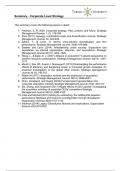Summary - Corporate Level Strategy
This summary covers the following papers in detail:
1. Feldman, E. R. 2020. Corporate strategy: Past, present, and future. Strategic
Management Review, 1 (1), 179-206.
2. Zhou (2011). Synergy, coordination costs, and diversification choices. Strategic
Management Journal, 32, 624-639.
3. Zahavi, T., & Lavie, D. (2013). Intra-industry diversification and firm
performance. Strategic Management Journal, 34(8), 978-998.
4. Stettner and Lavie (2014). Ambidexterity under scrutiny: Exploration and
exploitation via internal organization, alliances, and acquisitions, Strategic
Management Journal 35(13): 1903–1929.
5. Wang, L., & Zajac, E. J. (2007). Alliance or acquisition? A dyadic perspective on
interfirm resource combinations. Strategic Management Journal, 28(13), 1291-
1317.
6. Moatti V, Ren CR, Anand J, Dussauge P (2015) Disentangling the performance
effects of efficiency and bargaining power in horizontal growth strategies: An
empirical investigation in the global retail industry Strategic Management
Journal 36 (5), 745-757.
7. Rabier M (2017). Acquisition motives and the distribution of acquisition
performance. Strategic Management Journal 38(13): 2666-2681.
8. Chen, Crossland, and Huang (2016) Female board representation and
corporate acquisition intensity Strategic Management Journal 37(2): 303-313
9. Shi, Zhang, and Hoskisson (2017) Ripple effects of CEO awards: Investigating
the acquisition activities of superstar CEOs' competitors Strategic
Management Journal 38(10): 2080-2102.
10. Vidal and Mitchell (2015) Adding by subtracting: the relationship between
performance feedback and resource reconfiguration through divestitures.
Organization Science 26(4):1101-1118.
11. Feldman (2014) Legacy Divestitures: Motives and Implications. Organization
Science 25(3):815-832.
,Article 1. Corporate Strategy: Past, Present, and Future
Corporate scope decisions, such as mergers and acquisitions, alliances, and
divestitures, have the potential to create or destroy enormous amounts of shareholder
value, to significantly impact operating performance for better or for worse, and to
impose major organizational consequences on companies.
The outcomes of corporate strategy decisions fall far short of expectations or fail to
solve the underlying problem that motivated them to make those decisions in the first
place.
→ This is partly due to the underlying problems being poorly structured if even
articulated at all.
The article has a few goals:
• Giving arguments for the importance of corporate strategy as a research topic.
• Providing some new insights in how corporate strategy can fit into the field of
strategy.
• Presenting a three-part framework aimed at organizing the different topics and
phenomena that corporate strategy scholars study.
What is corporate strategy?
• Fundamentally concerned with: Explaining what enables firms to enjoy
sustainable performance advantages over their competitors.
In the field of strategy there is an important debate regarding the topic of corporate
strategy causes the emerging of two different research traditions.
• The tradition of Industrial Organization (OI)
• The tradition of the Research Based View (RBV)
For OI: Bain’s structure-conduct-performance paradigm informs the idea that industry
structure and firms’ positions therein are key determinants for their relative
performance.
• Tended to find evidence for a more significant industry effect than a business
unit effect on firm performance.
For RBV: Differences in performance are driven by the idiosyncratic and inimitable
resources and capabilities that companies have at their disposal.
• Tended to find evidence for a more significant business unit effect than an
industry effect on firm performance.
,This debate divided the field of strategy into two parts (each focus on different core
questions):
• Competitive strategy
• Corporate strategy
Competitive strategy
• Research is animated around analyzing how markets, technologies, and
organization might explain differences in firm performance.
Corporate strategy
• Seeks to address a different core question:
‘’How do managers set and oversee the scope of their firms?’’
So, how do managers determine which businesses belong within their firms and which
do not?
What transactions (M&As, Alliances, Divestures, etc.) do they undertake to achieve
that scope?
How do they allocate resources among their businesses, and how do they coordinate
or promote interdependencies across those businesses?
Differences in firm performance are important to corporate strategy since they serve
as an outcome. The decisions that the manager of a firm makes in response to the
above-mentioned questions lead that company to enjoy better performance than its
competitors.
• Answering questions regarding how managers set and oversee the scope of
their firms is the core objective of corporate strategy research.
, A framework for corporate strategy
The answer to the question of ‘how managers set and oversee the scope of their firms’
can be broken down into three key components:
• Managers coordinate resources within the boundaries of their firms.
• Managers coordinate relationships with other companies across the boundaries
of their firms.
• Managers decide which businesses belong within the boundaries of their firms
and which ones do not.
This framework of how managers set and oversee firm scope range from intra-
organizational to inter-organizational to extra organizational.
These three levels of managerial action emphasize the point that each of them offers
a distinct locus of engagement to vis-à-vis the focal firm.





